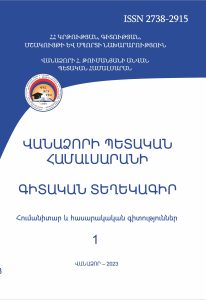An Overview of Contrastive Analysis of Intonation and Structural-Semantic Characteristics of Disjunctive (Tag Questions) and Alternative Questions in English and Armenian
Scientific Proceedings of Vanadzor State University Humanitarian and Social Sciences (ISSN 2738-2915)
2023 vol 1
An Overview of Contrastive Analysis of Intonation and Structural-Semantic Characteristics of Disjunctive (Tag Questions) and Alternative Questions in English and Armenian
Nune Marikyan
Summary
 Key words: communication, interrogative sentences, intonation pattern, question-word, literary speech, colloquial speech, limited choice, comparative analysis
Key words: communication, interrogative sentences, intonation pattern, question-word, literary speech, colloquial speech, limited choice, comparative analysis
In all languages intonation serves for the external colouring of speech because it is mainly by means of intonation we realize the character of the utterance, i. e, whether the utterance is a question or a declarative sentence (narrative). Moreover, by means of intonation we can express joy, surprise, displeasure or even irritation and anger. During the process of foreign speech-perception (even in case of good knowledge of language), finer shades of meaning uttered with unfamiliar intonation means are lost on the listener. The significance of complete oral speech-meaning presupposes the combination of corresponding proper grammar and lexical structures.
Two aspects should be distinguished in intonation. The first aspect can be called communicative, as through intonation we express complete and non-complete statements, find out whether the uttered statements contain questions or responses and so forth. The second aspect can be called emotional, as intonation contains certain emotional colouring which expresses the emotional state of the speaker, sometimes the speaker’s intention (not always fully perceived by him) to influence the imagination and the feelings of the listener.
The present research article provides overview of comparative analysis of intonation and structural-semantic characteristics of Disjunctive and Alternative questions in English and Armenian. The contrastive analysis of the intonation and structural-semantic characteristics of the above mentioned questions in English and Armenian, first of all, presupposes the corresponding choice of communicative types of speech which on their turn determine the choice of the similar speaking (speech) situations.
As a result of the analysis of the intonation and structural-semantic characteristics of Disjunctive and Alternative questions in English and Armenian, certain basic similarities and divergences are revealed in contrasted languages.
